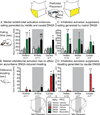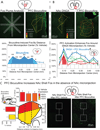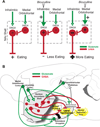Prefrontal cortex modulates desire and dread generated by nucleus accumbens glutamate disruption
- PMID: 22981656
- PMCID: PMC3535675
- DOI: 10.1016/j.biopsych.2012.08.009
Prefrontal cortex modulates desire and dread generated by nucleus accumbens glutamate disruption
Abstract
Background: Corticolimbic circuits, including direct projections from prefrontal cortex to nucleus accumbens (NAc), permit top-down control of intense motivations generated by subcortical circuits. In rats, localized disruptions of glutamate signaling within medial shell of NAc generate desire or dread, anatomically organized along a rostrocaudal gradient analogous to a limbic keyboard. At rostral locations in shell, these disruptions generate appetitive eating, but at caudal locations the disruptions generate progressively fearful behaviors (distress vocalizations, escape attempts, and antipredator reactions). Here, we asked whether medial prefrontal cortex can modulate intense motivations generated by subcortical NAc disruptions.
Methods: We used simultaneous microinjections in medial prefrontal cortex regions and in NAc shell to examine whether the desire or dread generated by NAc shell disruptions is modulated by activation/inhibition of three specific regions of prefrontal cortex: medial orbitofrontal cortex, infralimbic cortex (homologous to area 25 or subgenual anterior cingulate in the human), or prelimbic cortex (midventral anterior cingulate).
Results: We found that activation of medial orbitofrontal cortex biased intense bivalent motivation in an appetitive direction by amplifying generation of eating behavior by middle to caudal NAc disruptions, without altering fear. In contrast, activation of infralimbic prefrontal cortex powerfully and generally suppressed both appetitive eating and fearful behaviors generated by NAc shell disruptions.
Conclusions: These results suggest that corticolimbic projections from discrete prefrontal regions can either bias motivational valence or generally suppress subcortically generated intense motivations of desire or fear.
Copyright © 2013 Society of Biological Psychiatry. Published by Elsevier Inc. All rights reserved.
Conflict of interest statement
All authors report no biomedical financial interests or potential conflicts of interest.
Figures






Similar articles
-
Nucleus accumbens dopamine/glutamate interaction switches modes to generate desire versus dread: D(1) alone for appetitive eating but D(1) and D(2) together for fear.J Neurosci. 2011 Sep 7;31(36):12866-79. doi: 10.1523/JNEUROSCI.1339-11.2011. J Neurosci. 2011. PMID: 21900565 Free PMC article.
-
Desire or Dread from Nucleus Accumbens Inhibitions: Reversed by Same-Site Optogenetic Excitations.J Neurosci. 2020 Mar 25;40(13):2737-2752. doi: 10.1523/JNEUROSCI.2902-19.2020. Epub 2020 Feb 19. J Neurosci. 2020. PMID: 32075899 Free PMC article.
-
Desire and dread from the nucleus accumbens: cortical glutamate and subcortical GABA differentially generate motivation and hedonic impact in the rat.PLoS One. 2010 Jun 18;5(6):e11223. doi: 10.1371/journal.pone.0011223. PLoS One. 2010. PMID: 20585461 Free PMC article.
-
Prefrontal cortex-nucleus accumbens interaction: in vivo modulation by dopamine and glutamate in the prefrontal cortex.Pharmacol Biochem Behav. 2008 Aug;90(2):226-35. doi: 10.1016/j.pbb.2008.04.011. Epub 2008 Apr 23. Pharmacol Biochem Behav. 2008. PMID: 18508116 Review.
-
Feeding-modulatory effects of mu-opioids in the medial prefrontal cortex: a review of recent findings and comparison to opioid actions in the nucleus accumbens.Psychopharmacology (Berl). 2017 May;234(9-10):1439-1449. doi: 10.1007/s00213-016-4522-4. Epub 2017 Jan 4. Psychopharmacology (Berl). 2017. PMID: 28054099 Free PMC article. Review.
Cited by
-
Social discounting of pain.J Exp Anal Behav. 2020 Nov;114(3):308-325. doi: 10.1002/jeab.631. Epub 2020 Oct 7. J Exp Anal Behav. 2020. PMID: 33026113 Free PMC article.
-
The matter of motivation: Striatal resting-state connectivity is dissociable between grit and growth mindset.Soc Cogn Affect Neurosci. 2016 Oct;11(10):1521-7. doi: 10.1093/scan/nsw065. Epub 2016 May 11. Soc Cogn Affect Neurosci. 2016. PMID: 27217105 Free PMC article.
-
Methamphetamine acutely alters frontostriatal resting state functional connectivity in healthy young adults.Addict Biol. 2020 May;25(3):e12775. doi: 10.1111/adb.12775. Epub 2019 May 16. Addict Biol. 2020. PMID: 31099141 Free PMC article.
-
The Multifaceted Role of the Ventromedial Prefrontal Cortex in Emotion, Decision Making, Social Cognition, and Psychopathology.Biol Psychiatry. 2018 Apr 15;83(8):638-647. doi: 10.1016/j.biopsych.2017.10.030. Epub 2017 Nov 20. Biol Psychiatry. 2018. PMID: 29275839 Free PMC article. Review.
-
Incentive motivation: 'wanting' roles of central amygdala circuitry.Behav Brain Res. 2021 Aug 6;411:113376. doi: 10.1016/j.bbr.2021.113376. Epub 2021 May 20. Behav Brain Res. 2021. PMID: 34023307 Free PMC article. Review.
References
-
- Kompus K, Hugdahl K, Ohman A, Marklund P, Nyberg L. Distinct control networks for cognition and emotion in the prefrontal cortex. Neurosci Lett. 2009;467:76–80. - PubMed
-
- Phillips AG, Vacca G, Ahn S. A top-down perspective on dopamine, motivation and memory. Pharmacology Biochemistry and Behavior. 2008;90:236–249. - PubMed
-
- Siep N, Roefs A, Roebroeck A, Havermans R, Bonte M, Jansen A. Fighting food temptations: The modulating effects of short-term cognitive reappraisal, suppression and up-regulation on mesocorticolimbic activity related to appetitive motivation. Neuroimage. 2012;60:213–220. - PubMed
-
- Phan KL, Fitzgerald DA, Nathan PJ, Moore GJ, Uhde TW, Tancer ME. Neural substrates for voluntary suppression of negative affect: a functional magnetic resonance imaging study. Biol Psychiatry. 2005;57:210–219. - PubMed
Publication types
MeSH terms
Substances
Grants and funding
LinkOut - more resources
Full Text Sources
Other Literature Sources

